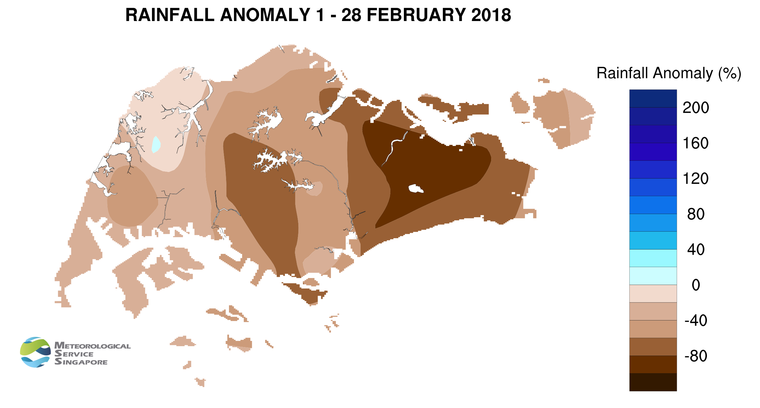More afternoon thundery showers expected in first half of March 2018 following a dry February 2018. A few warm days expected with daily maximum temperature around 34°C.
Singapore, 1 March 2018 – Singapore and the surrounding region will continue to experience Northeast Monsoon conditions in the first fortnight of March 2018. The low level winds during this period are forecast to blow mostly from the northwest or northeast.
2 In the first two weeks of March 2018, more showers are expected to fall over the island compared to the last fortnight of February 2018. The thundery showers are forecast mostly in the afternoon on seven to nine days arising mainly from daytime heating of land areas. On a few of these days, the thundery showers are likely to extend into the evening. In addition, a weak monsoon surge[1] could affect the South China Sea and the surrounding region in the latter half of the fortnight. The surge is likely to bring windy conditions with passing showers and cooler temperatures to Singapore on a few days. The rainfall for the first two weeks of March 2018 is expected to be near normal.
3 The daily temperature on most days in the next fortnight is forecast to range between 23°C and 33°C. Warm conditions can be expected on a few days when the daily maximum temperature climbs to around 34°C.
4 For updates of the daily weather forecast, please visit the MSS website (https://www.weather.gov.sg), NEA website (www.nea.gov.sg), or download the myENV app, or the MSS’ Weather@SG app.
REVIEW (1 – 28 February 2018)
5 February 2018 saw the onset of the dry phase of the Northeast Monsoon season. The low level winds blew predominantly from the north or northeast, and on the whole, there was not much rain that fell over the island.
6 In the first week of the month, a weak monsoon surge brought windy conditions with some passing showers to the island. Between 5 February and 14 February, a dry air mass from northern Asia was blown by the prevailing northerly to northeasterly winds to the Southeast Asia region, including Singapore. The dry air brought seven consecutive dry days between 7 February and 13 February, with no rainfall recorded over the island. The second half of February 2018 saw more showers compared to the first half of the month. The thundery showers fell mostly over the western, central and southern parts of the island in the afternoon and evening on several days due to daytime heating of land areas coupled with convergence of winds in the vicinity. The heaviest rainfall was recorded on 28 February 2018 where the 93.5mm of rain was recorded at the station in Woodlands.
7 In February 2018, the daily maximum temperature ranged between 29.4°C and 35.1°C, and the daily minimum temperature ranged between 22.0°C and 25.2°C. The highest temperature of 35.1°C was recorded at Choa Chu Kang on 22 February 2018.
8 Almost all parts of Singapore received well below-normal rainfall in February 2018. The lowest rainfall of 17mm (87% below average) was recorded in eastern Singapore. Rainfall was highest at Choa Chu Kang where 148.2mm (4% above average) was recorded.
[1] A monsoon surge refers to the strengthening of northeasterly winds blowing from a strong high-pressure system over the northern Asian continent toward the South China Sea, bringing periods of prolonged widespread rain and windy conditions to the surrounding region including Singapore and Peninsular Malaysia. (Further information is available at https://www.weather.gov.sg/learn_weather_systems/).
CLIMATE STATION STATISTICS FOR MARCH (Climatological reference period: 1981 – 2010)
| Mean daily maximum temperature | 32.0 °C |
| Mean daily minimum temperature | 24.6 °C |
| Mean monthly temperature | 27.5 °C |
| Mean rainfall for the month | 170.3 mm |
| Mean number of rain days | 13 |
| Highest monthly mean daily maximum temperature | 34.1 °C (1998) |
| Lowest monthly mean daily minimum temperature | 23.7 °C (1982) |
| Highest monthly rainfall | 361.3 mm (1984) |
| Lowest monthly rainfall | 34.3 mm (1997) |

